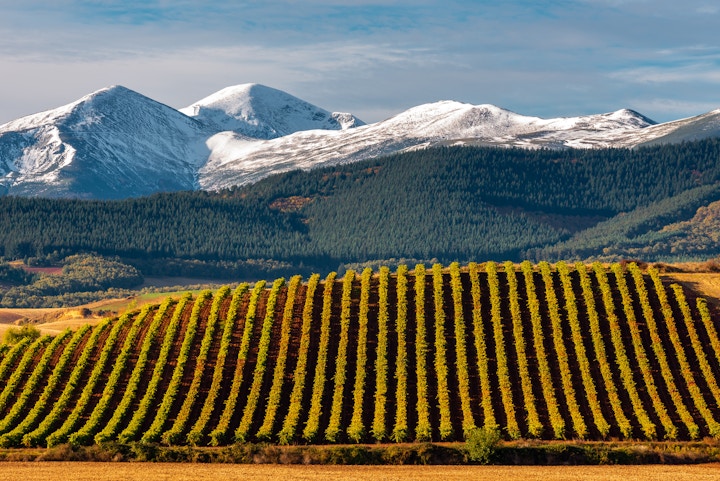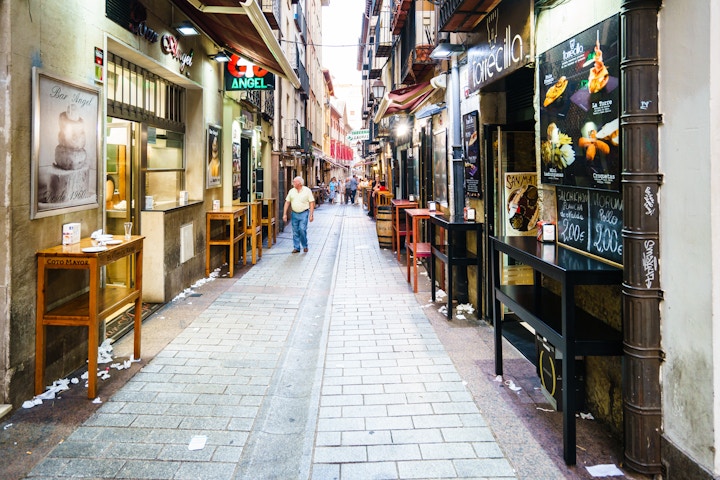48 hours in La Rioja: What to eat, drink and do
La Rioja is Spain’s most lauded wine region, located in the north east, just two hours south of the culinary hotspot of San Sebastián. Exploring the region on four wheels is definitely the way to go and if you're looking at accomodation, check out the provincial capital of Logroño. There's plenty to eat, drink and do, and ideally you'll have more than 48 hours but if you don't, arm yourself with our handy guide for the best of the region.
La Rioja shows you the best of small and medium sized Spain - no urban hustle and bustle here. It's important to mention that much of the region lies in País Vasco (the independent Basque Country region of Spain). La Rioja is split into Alta, Baja and Alavesa, with the latter being situated in País Vasco, where you will see signs in both Spanish and Basque and the occasional octogenarian farmer on a vintage tractor, wearing the famous Basque beret. If your visit to La Rioja falls during harvest time (September/October), hillsides are likely to be dotted with tractors carrying grapes from vineyards to wineries at all times of the day and night - it's quite the sight.
Mofo Tip: For first-time visitors in Spain, the best 48 hours in any region will most likely not include a Sunday, as most wineries will be closed.

Day 1: In the daytime
All over Spain, the best place to start your day is in a local market. In the case of Logroño, that’s Mercado de Abastos. Grab a seat at one of the market’s small bars, where you’ll find sandwiches on display (perhaps a freshly made tortilla, if you're lucky!) and a delicious, hot coffee. It’s a local’s market, so we'd recommend stocking up on fresh produce so you can snack well throughout the day.
From Logroño, head to the town of Briones, where you will find Vivanco Museum of Wine Culture. There is a lot to see in this complex, including guided visits, wine tastings of the Vivanco range and a restaurant. We suggest a self-guided tour of the Museum of Wine Culture to immerse yourself in a bit of wine growing and making before you get stuck into the imbibing side of things...
Feeling peckish? Laguardia is our recommendation for a wonderful lunch stop and stroll around. Laguardia is a walled medieval town that houses a collection of micro-wineries and some of the best views of the region, along with a historical centre, with the oldest structures dating back to the 12th century. Let your nose do the work as you stroll around the beautiful streets - there are small bars and bakeries, along with a few more serious dining options, such as Restaurante Amelibia, with traditional food from local ingredients if you're keen on a longer lunch. As for wineries, there are a few small wineries in the city walls where you can pop in for a tasting, such as El Fabulista and Entre Viñas y Olivos.
Within a few kilometres of the town are some of the region's best producers. Without sounding non-committal, I can say that there are countless great options for winery tours in this part of La Rioja. Due to the ageing regulations in the region (see 'A Beginner's Guide to La Rioja'), the barrel halls (above and below ground) range from impressive to breathtaking. Wine tourism in La Rioja is very well established, so if you get a recommendation from a fellow traveller (and wine lover) - we suggest you take it *wink wink*. Just outside of Laguardia, there is Artadi with their exceptional single vineyard wines, and a bit further south in Fuenmayor, swing by the very impressive Altanza for a tasting and a full tour if you have time. Altanza is modern Rioja, with a 100% focus on quality, which is reflected in all parts of their winery, vineyard and staff - it's definitely a must visit.
Day 1: In the night time
A weekend in La Rioja has to include at least one night in Logroño, the Roman town on the pilgrimage route to Santiago de Compostela. With over 50 taperías in the blocks surrounding the famous Calle Laurel, it’s a damn fun way to dine - bar crawling from venue to venue, sampling the house specialities.

Although it’s best to let your eyes lead your stomach through the laneways and windows full of delicacies, a recommendation never goes astray. Bar Soriano is a good place to start with their famous champiñón a la plancha con gamba (grilled mushroom with prawn). The wine list at the time of visiting (October, 2018) had a selection of wine by the glass (the size would have been about half the volume of a standard Australian glass) from 0.80-1.50€. Not exactly fine wine, but no complaints here.
Jamonero Pata Negra, which as the name suggests, specialises in Jamón has a considerable wine list, including some of the best producers from the region. If you're looking for something more classic, try the López de Herida Gran Reserva or one of the Sierra Cantabria single vineyard wines. If you're looking for more contemporary producers, you’ll find all sorts from across La Rioja, at various styles and price points.
Day 2: In the daytime
After all of the copas and tapas from the night before, we’d suggest heading back to the market for a coffee and fresh fruit fix. Spanish cuisine is punctuated by pork, cheese, bread and eggs, so fresh produce for on-road snacks will help you feel more bouncy than blah.
Once you're caffeinated, jump in the car and head west towards Haro, the region’s vinous centre. Take the long road and make a stop to family-run winery Valserrano in Villabuena de Álava to try their epic single vineyard wines and have a look at their cellar. Along with the classic and beautifully-crafted red wines made from tempranillo, Valserrano make a barrel-aged white (Blanco Gran Reserva) which is well worth tasting, as it's a top notch example of the rare style. This is a small operation, so make sure you get in contact a few days in advance to book a tasting. Spanish speakers may even get a tasting with family patriarch, Juan Pablo, who is an absolute delight.

From Valserrano, head to Haro and on your way west, make sure you swing past Labastida to see the beautiful mural in El Frontin Kalea ('kalea' means street in Basque). Once in Haro, a stop at the railway station and the surrounding 19th century wineries is a must. If you're travelling in September, there's the unmissable Haro Train Station District Wine Festival (La Cata del Barrio de la Estación) - the next event is in 2020. Otherwise, stop for a tour of the iconic López De Heredia (an absolute must!) to see where their Viña Tondonia reds, whites, oranges and goldens are made. There is truly nothing like this producer or their wines in the world and this is definitely the place to begin your journey into Rioja wines.
For lunch, head into Restaurante El Claustro (meaning cloister) which is set in the Augustinian monastery of Hotel Los Agustinos - a classic place to stop and soak in the history of a building that has served as all sorts of civic and military, as well as religious roles over the years. Old-school and beautiful, it’s worth staying for a couple of courses in their charming atrium.
As your 48 hours come to an end, make sure you finish up in the town of Elciego to visit the iconic new hotel, restaurant and bar at Marqués de Riscal. How, you may ask, can a place be both new and iconic at the same time? One look at the Frank Gehry (of Guggenheim) designed building will answer that question, as it shines and shimmers amidst the medieval town like a fabulous drag queen in a monastery. This is well worth a visit and by the time you arrive, you’ll most likely order a beer after a non-stop weekend of delicious reds. Salud!
If you can't afford a ticket to La Rioja, take your tastebuds on a trip with a case of Sierra Cantabria Selección 2016.
